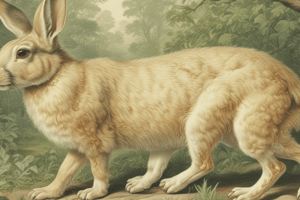Podcast
Questions and Answers
What is the primary purpose of mating behaviors in animals?
What is the primary purpose of mating behaviors in animals?
- To attract mates and ensure reproduction (correct)
- To defend territory from predators
- To establish dominance within a group
- To communicate with other species
What is the primary difference between sexual and asexual reproduction?
What is the primary difference between sexual and asexual reproduction?
- The complexity of the reproductive cycle
- The number of offspring produced
- The involvement of gametes in the process (correct)
- The energy investment in reproduction
Which of the following is an example of a mating behavior in insects?
Which of the following is an example of a mating behavior in insects?
- Lek system (correct)
- Vocalizations
- Scent marking
- Courship dances
What is the outcome of sexual reproduction in terms of offspring genetics?
What is the outcome of sexual reproduction in terms of offspring genetics?
Which reproductive strategy does not involve gametes?
Which reproductive strategy does not involve gametes?
What is the role of parental care in animal reproduction?
What is the role of parental care in animal reproduction?
What influences the reproductive cycles of animals?
What influences the reproductive cycles of animals?
Which type of animals typically have a short reproductive cycle with multiple breeding seasons per year?
Which type of animals typically have a short reproductive cycle with multiple breeding seasons per year?
What is the process by which a fertilized egg develops into a mature organism?
What is the process by which a fertilized egg develops into a mature organism?
How long does embryonic development typically take in mammals?
How long does embryonic development typically take in mammals?
What is the primary purpose of parental care in animals?
What is the primary purpose of parental care in animals?
Which type of animals typically have a low level of parental care?
Which type of animals typically have a low level of parental care?
Study Notes
Animal Reproduction: Understanding Mating Behaviors, Reproductive Strategies, Cycles, Embryonic Development, and Parental Care
Animal reproduction is a crucial aspect of an organism's life cycle. It involves various stages, from mating behaviors and reproductive strategies to reproductive cycles and embryonic development. Additionally, parental care plays a significant role in the survival and growth of offspring. In this article, we will explore these topics in detail.
Mating Behaviors
Mating behaviors vary widely among species. Some animals engage in elaborate courtship rituals, while others practice polygamy or have no specific mating behaviors at all. For example, some insects engage in a "lek" system, where males gather in a specific area and display their attributes to attract mates. Other animals, such as mammals, may have more subtle mating behaviors, such as scent marking or vocalizations.
Reproductive Strategies
Reproductive strategies can be divided into two main categories: sexual and asexual reproduction. Sexual reproduction involves the fusion of gametes (sperm and eggs) from two individuals, resulting in offspring with a combination of genetic traits from both parents. Asexual reproduction, on the other hand, does not involve gametes and can occur through various mechanisms, such as fission, budding, or parthenogenesis.
Reproductive Cycles
Reproductive cycles vary among species and are often influenced by environmental factors such as temperature and photoperiod. Some animals have a single breeding season per year, while others may breed multiple times. For example, some mammals, such as rodents, have a short reproductive cycle with multiple breeding seasons per year, while others, such as humans, have a longer reproductive cycle with a single breeding season.
Embryonic Development
Embryonic development is the process by which a fertilized egg develops into a mature organism. This process can involve various stages, such as cleavage, gastrulation, and organogenesis. The length of the embryonic development stage varies among species, from the few weeks it takes for a mammalian embryo to develop to the several months it takes for a reptile embryo to hatch.
Parental Care
Parental care refers to the various behaviors exhibited by parents to ensure the survival and growth of their offspring. This can include providing food, protection, and guidance. The extent of parental care varies among species. Some animals, such as mammals, have a high level of parental care, while others, such as birds, may have little to no parental care.
In conclusion, animal reproduction is a complex process that involves various behaviors, strategies, cycles, developmental stages, and care practices. Understanding these aspects can provide valuable insights into the biology of animals and their evolution.
Studying That Suits You
Use AI to generate personalized quizzes and flashcards to suit your learning preferences.
Description
Explore the various stages of animal reproduction, from mating behaviors and reproductive strategies to reproductive cycles, embryonic development, and parental care. Learn about the differences and similarities among species and how they ensure the survival and growth of their offspring.




